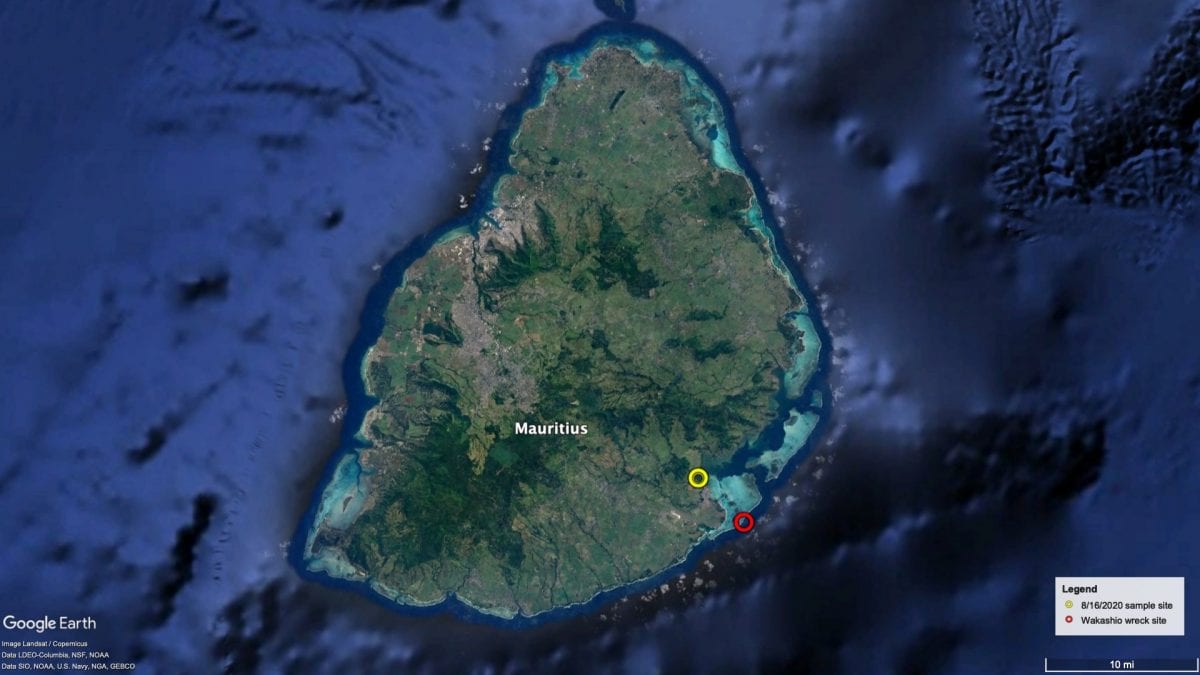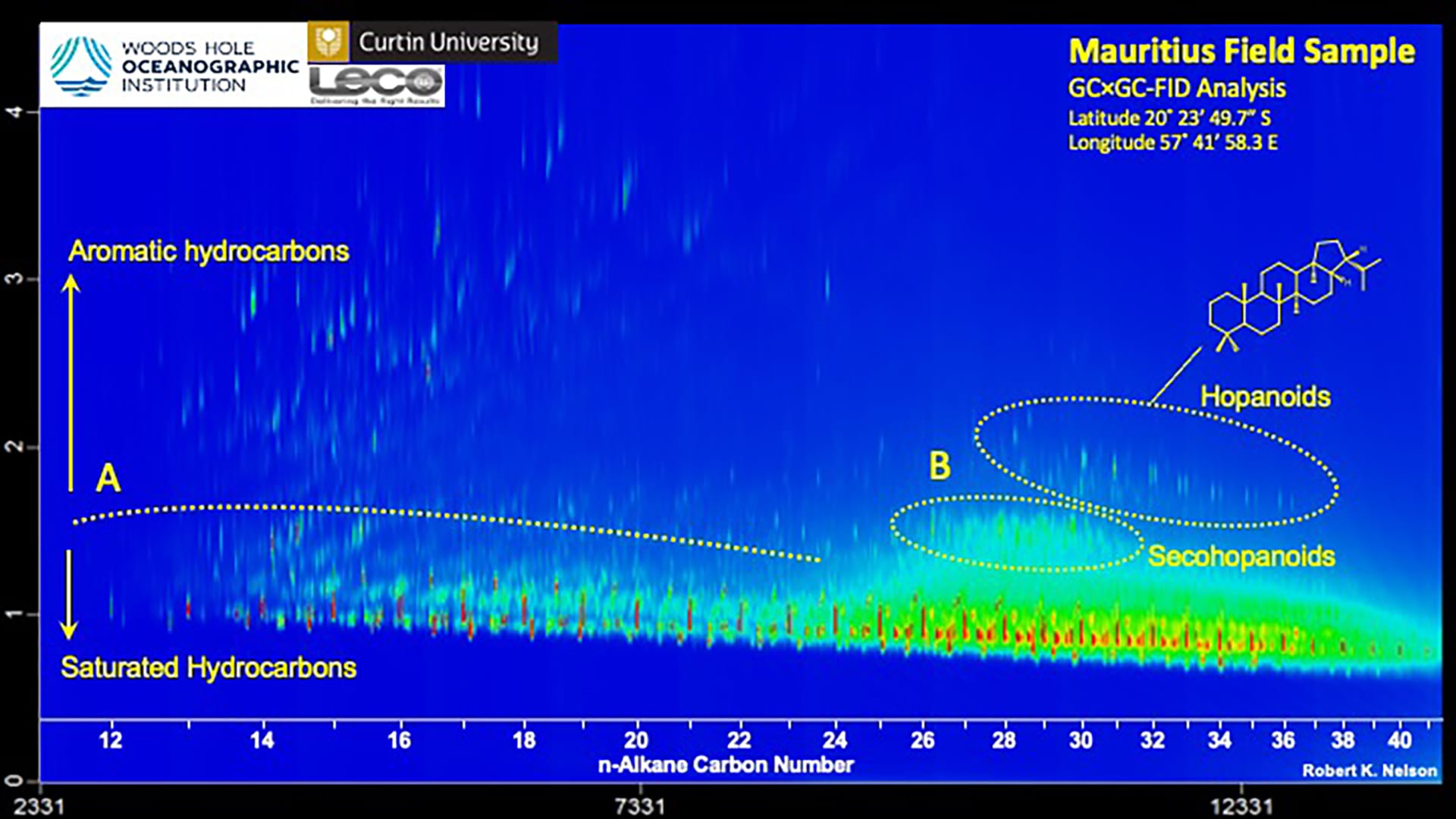First Detailed Oil Sample Analysis Completed from Mauritius Oil Spill
 Location of the wreck of the ship Wakashio, which went aground on a reef off the coast of Mauritius on July 25, 2020, and began leaking fuel oil on August 6, as well as the location of an oil sample collected on August 16 analyzed by teams at Curtin University in Perth, Australia, and the Woods Hole Oceanographic Institution. (Google Earth map produced by Woods Hole Oceanographic Institution)
Location of the wreck of the ship Wakashio, which went aground on a reef off the coast of Mauritius on July 25, 2020, and began leaking fuel oil on August 6, as well as the location of an oil sample collected on August 16 analyzed by teams at Curtin University in Perth, Australia, and the Woods Hole Oceanographic Institution. (Google Earth map produced by Woods Hole Oceanographic Institution) October 29, 2020
When the Japanese bulk carrier MV Wakashio struck a coral reef off the coast of Mauritius on July 25, 2020, and began leaking fuel oil two weeks later, local residents and the international community sprang into action to protect the pristine habitats that fringe the Indian Ocean nation. But they did so without insight from careful chemical analysis, which is customary after spills to help guide short and long-term response plans and protects the health of people facing such a spill.
Now the first ultra-high-resolution analysis of an oil sample from Mauritius shows that the material is a complex and unusual mix of hydrocarbons—and even though some of the components in it may have already degraded or evaporated, what remains still gives it the ability to persist in the environment. That is the conclusion of marine oil spill experts Chris Reddy and Bob Nelson at the Woods Hole Oceanographic Institution (WHOI), who are collaborating with Professor Kliti Grice, Director of the Western Australian Organic Isotope Geochemistry Centre (WA-OIGC) and Associate Professor Monique Gagnon and Alan Scarlett at Curtin University in Perth, Australia. Both teams analyzed a sample of floating residue collected August 16. They subjected it to many of the same analytical techniques used to “fingerprint” samples from other large spills around the world.
The two teams use comprehensive two-dimensional gas chromatography (GC×GC), complemented by compound-specific isotope analyses to identify compounds specific to spilled oils. The analyses performed by the two laboratories provide some of the most highly advanced analytical services and scientific support to oil spill responders. They found their results were consistent with what they would expect from a sample of fuel oil, which is a non-standardized mix of petroleum products that ships often use to run their engines. In recent years, calls to improve air quality around ports has driven the industry to adopt new low-sulfur formulations that reduce emissions. At the same time, however, the potential is rising for spills of this type, but the scientific community has yet to see what happens to these new low-sulfur fuels when they enter the environment.
Key Takeaways
- Marine oil spill experts from Woods Hole Oceanographic Institution recently provided one of the first detailed oil sample analysis from the July 25 Mauritius oil spill.
- WHOI worked with experts from the Western Australian Organic Isotope Geochemistry Centre (WA-OIGC) and Curtin University in Perth, Australia.
- Their analysis shows that the material is a complex and unusual mix of hydrocarbons.
- This type of analysis is the gold standard in oil spills—it’s not only used to fingerprint the oil, but also to positively identify the constituent parts of an oil to figure out how to best fight a spill and guide short and long-term response plans while protecting the health of people facing such a spill.
“Fuel oils, are arguably the most challenging petroleum products to analyze and investigate following marine-based spills,” said Reddy. “There is no single recipe or set of ingredients, and it gets even more complicated with these new low-sulfur fuel oils that require more steps in their manufacture. We don’t know if this was a low-sulfur material, but it’s unlike anything we’ve seen spilled before—that alone demands a closer look.”
Analysis by WA-OIGC at Curtin and also confirmed by WHOI’s Organic Geochemistry Analysis Lab showed that the sample contained relatively low levels of polycyclic aromatic hydrocarbons (PAHs), which are known carcinogens in humans and animals. Although low, the levels of PAHs might accumulate in certain parts of the marine environment. In addition, Reddy found a relatively high concentration and variety of secohopanes and surprisingly low levels of hopanes, both of which are “biomarkers” that will help connect future samples of oil to the Wakashio ship. These substances were present in minute amounts, but still detectable thanks to the technology available in the collaborating laboratories. Only comparison to a “fresh” sample taken from the ship would allow researchers to determine what has already been lost from the oil as a result of evaporation, dilution, photodegradation, and other effects.
“This was just a first step,” said Grice. “Our limited view of what spilled only reinforces the need for long-term monitoring, access to samples from the ship, and a more in-depth analysis that officials can incorporate into detailed plans to help Mauritius and its environment recover from this.”
The sample was acquired by Associate Professor Monique Gagnon at Curtin University. If members of the public have photos of oil and oiled material or other information, including photos of unoiled beaches and reefs, that might help Reddy and Grice and their research teams better understand the nature of the spill, they are welcome to email oilsamples@whoi.edu.
The Woods Hole Oceanographic Institution (WHOI) is a private, non-profit organization on Cape Cod, Massachusetts, dedicated to marine research, engineering, and higher education. Established in 1930, its primary mission is to understand the ocean and its interaction with the Earth as a whole, and to communicate an understanding of the ocean’s role in the changing global environment. WHOI’s pioneering discoveries stem from an ideal combination of science and engineering—one that has made it one of the most trusted and technically advanced leaders in basic and applied ocean research and exploration anywhere. WHOI is known for its multidisciplinary approach, superior ship operations, and unparalleled deep-sea robotics capabilities. We play a leading role in ocean observation, and operate the most extensive suite of data-gathering platforms in the world. Top scientists, engineers, and students collaborate on more than 800 concurrent projects worldwide—both above and below the waves—pushing the boundaries of knowledge and possibility. For more information, please visit www.whoi.edu

